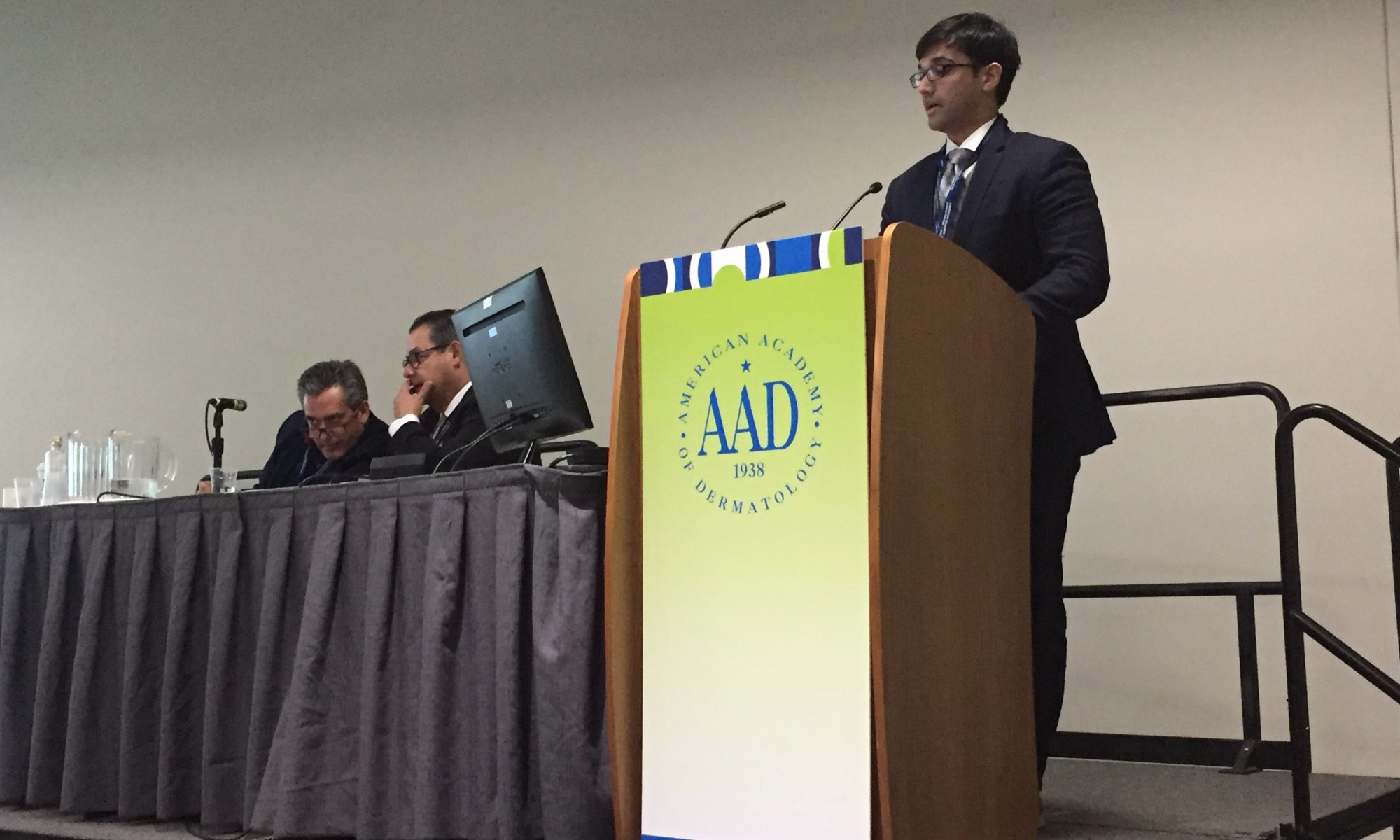Introduction
I am honored to have been invited to contribute to Next Steps in Derm! My name is Azam Qureshi and I recently completed a year working as a dermatology research fellow. I completed my fellowship between my third and fourth years of medical school. I hope that speaking about my experiences as a research fellow and prospective dermatology trainee will contribute to provide a valuable perspective about your own fit in the exciting world of dermatology.
The uniqueness of dermatology is rooted in providers’ ability to practice a variety of aspects of clinical medicine. These include histopathological diagnosis and surgical treatment of cancer, medical management of chronic disease, and even some psychiatry. While these factors alone make dermatology appealing, what draws me most to the field is the unique patient population, which I have encountered on both a personal and professional level. Dermatology patients encounter quality of life and psychosocial impacts distinctive from patients of other medical specialties due to a combination of visible disease and distressing symptoms.
The decision
In my third year of medical school, I was thrilled to receive an offer to work as a yearlong clinical research fellow in dermatology. The decision to go all-in and follow the growing trend for dermatology applicants was natural for me, given my strong interest in clinical investigation developed in college. Although research fellowship opportunities can come in many varieties, the position I pursued uniquely combined firsthand experience with both investigator-initiated and industry-sponsored dermatology research, clinical dermatology, and departmental education.
I have been fortunate enough to work on projects across many disciplines of dermatology this past year. I have found particular interests in wound healing, pruritus, and contact dermatitis. One of the most exciting projects I am working on is a trial studying the efficacy of topical collagen powder for healing of acute wounds using a human punch biopsy wounding model (NCT03481907). Under the mentorship of Principal Investigator Dr. Adam Friedman, we are comparing this topical intervention to primary closure, the current standard-of-care for treating punch biopsy wounds. It has also been very rewarding to lead Dr. Friedman’s site to be a global frontrunner in enrollment for the industry-sponsored Longitudinal Trial to Understand Symptomatology in Prurigo Nodularis (LOTUS) study. This non-interventional study seeks to characterize symptoms and biomarkers for this often difficult-to-treat disease.
Lastly, under the guidance of Dr. Alison Ehrlich, I have had the unique opportunity to design and implement my own original studies. This included a survey study aiming to characterize racial influences on quality of life and sleep changes after patch testing in patients with allergic contact dermatitis.
A day in the life of a research fellow
My daily activities consisted of managing these studies, along with numerous others in a department with an active clinical research program. In order to achieve the rewarding feeling of seeing a project transform from an idea into a reality, the heavy administrative obligations of initiating and keeping clinical projects running require excellent time management and organization skills. The ability to multitask is a necessity in order to juggle grant proposals, institutional review board submissions, meetings, training for industry-sponsored trials, sponsor correspondence, and other tasks related to documentation for studies.
With such a busy schedule, efficiency is pivotal. This is especially true for a future applicant who is also trying to make time for publications. This often requires its own sets of correspondence with journals and occasionally extensive revisions processes. I quickly realized that my ever-growing inbox required me to make the most of any time during the day. This included responding to most of my emails while walking to and from clinic! Although daunting at first, I am tremendously appreciative for this opportunity for professional development. It will help me to better handle the inevitable multitasking and administrative work expected of a resident and attending physician.
In addition to research, I had the great opportunity to assist three afternoons each week in patch testing and psoriasis, rheumatology and dermatology, and juvenile dermatomyositis specialty clinics. I participated in the departmental educational curriculum as well. This included Clinicopathologic Conferences, Journal Club meetings, and Grand Rounds presentations. I also met a fantastic group of residents who have all been mentors to me. These clinical and educational opportunities have contributed to a very well-rounded immersion into the field of academic dermatology while showing me glimpses into what I hope to achieve in my own career.
Final thoughts
I hope that this whirlwind tour of a dermatology clinical research fellow conveys the tremendously useful experience it has been. Many pursue a year off to merely improve their résumés, but as I look back upon this experience, I understand that the value of dermatology education, mentorship, and relationships gained cannot be understated. With this snapshot, it is my goal for readers to reflect on their own careers, regardless of level of training. No matter the current stage of your career, this piece is meant to help you reflect on where you have been in your own career and where you will go from here.

